Don't wanna be here? Send us removal request.
Text
MOVING!!!
My main account got hacked, so everything lock, stock, and barrel has to go.
I've made a new account with the same avatar and basically the same name: legends-collection. It doesn't have a lot of boogedies yet, and I'm moving my guys out of this one to the other so they can all be together like one big happy family.
The formatting and tagging system will be just as before.
If you guys have any questions or concerns, feel free to message me there and I'll try to get to it as soon as possible.
Hope to see you soon!
1 note
·
View note
Text
The Yara-ma-yha-who is a legendary creature found in Australian Aboriginal mythology. The legend is recounted by David Unaipon. According to legend, the creature resembles a little red frog-like man with a very big head, a large mouth with no teeth and suckers on the ends of its hands and feet.

Pic by tohdraws on deviantart
The Yara-ma-yha-who is said to live in fig trees. Instead of hunting for food, it is described as waiting for an unsuspecting traveller to rest under the tree. The creature then drops down and uses its suckers to drain the victim's blood. After that it swallows the person, drinks some water, and then takes a nap. When the Yara-ma-yha-who awakens, it regurgitates the victim, leaving them shorter than before. The victim's skin also has a reddish tint to it that it didn't have before. If this process is repeated, the victim becomes a Yara-ma-yha-who themselves.
According to legend, the Yara-ma-yha-who is only active during the day and only targets living prey. "Playing dead" until sunset (it is said to only hunt during the day) is offered as a ploy to avoid attack. Stories of this creature were reportedly told to misbehaving children.
32 notes
·
View notes
Text
Wewe Gombel is a female supernatural being or vengeful ghost in Javanese mythology. It is said that she kidnaps children.
This myth is taught to encourage children to be cautious and to stay at home at night. Traditionally, the Wewe Gombel is represented as a woman with long, hanging breasts. Modern representations include vampire-like fangs. This is a popular spirit that also appears in comics.
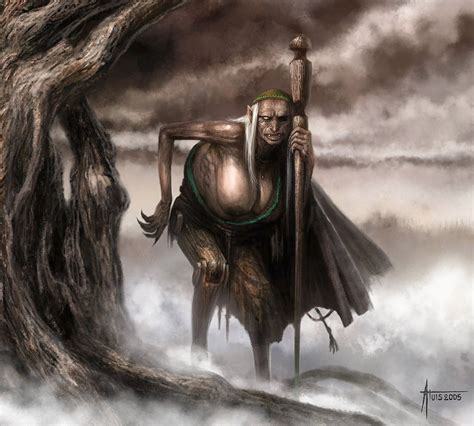
The ghost was named Wewe Gombel because it is related to an event that, according to ancient folklore, happened in Bukit Gombel, Semarang, where long ago a married couple lived. They had been married for years, but as time went by the husband realized that his wife was barren and stopped loving her. The husband became wayward, neglecting his wife and leaving her alone for long periods so she lived in sorrow. One day, she followed him and caught him in a sexual relationship with another woman. Hurt by her husband's betrayal she became furious and killed him. Faced with the crime, angry neighbors gathered in a mob and chased her from the village. Despairing at the ostracization and continual harassment, she committed suicide.
After death, her vengeful spirit became Wewe Gombel. Sundanese folklore says that she dwells in the crown of the Arenga pinnata palm, where she has her nest and keeps the children she catches. She does not harm them and once they are under her clutches they are not afraid of her.
Local traditions say that the children she abducts have been mistreated or neglected by their parents. She treats the children lovingly as a grandmother would, taking care of them and protecting them until their parents repent, at which point she returns them.
Wewe Gombel has affinities with the ghost known as Hantu Kopek in Malay folklore.
7 notes
·
View notes
Text
vengeful Ghost
In mythology and folklore, a vengeful ghost or vengeful spirit is said to be the spirit of a dead person who returns from the afterlife to seek revenge for a cruel, unnatural or unjust death. In certain cultures where funeral and burial or cremation ceremonies are important, such vengeful spirits may also be considered as unhappy ghosts of individuals who have not been given a proper funeral.

The concept of a vengeful ghost seeking retribution for harm that it endured as a living person goes back to ancient times and is part of many cultures. According to such legends and beliefs, they roam the world of the living as restless spirits, seeking to have their grievances redressed, and may not be satisfied until they have succeeded in punishing either their murderers or their tormentors.
In certain cultures vengeful ghosts are mostly female, said to be women that were unjustly treated during their lifetime. Such women or girls may have died in despair or the suffering they endured may have ended up in early death caused by the ill-treatment or torture they were subject to.
Exorcisms and appeasement are among the religious and social customs practiced by various cultures in relation to the vengeful ghost. The northern Aché people group in Paraguay cremated old people thought to harbor dangerous vengeful spirits instead of giving them a customary burial. In cases where the person has been killed and the body disposed of unceremoniously, the cadaver may be exhumed and reburied according to the proper funerary rituals in order to appease the spirit. Another option is to salt and burn their remains (bones).
3 notes
·
View notes
Text
Tunda
The Tunda is a myth of the Pacific coastal region of Colombia and Ecuador, and particularly in the Afro-Colombian community of the Chocó department, about a shapeshifting entity, resembling a human woman, that lures people into the forests and keeps them there.
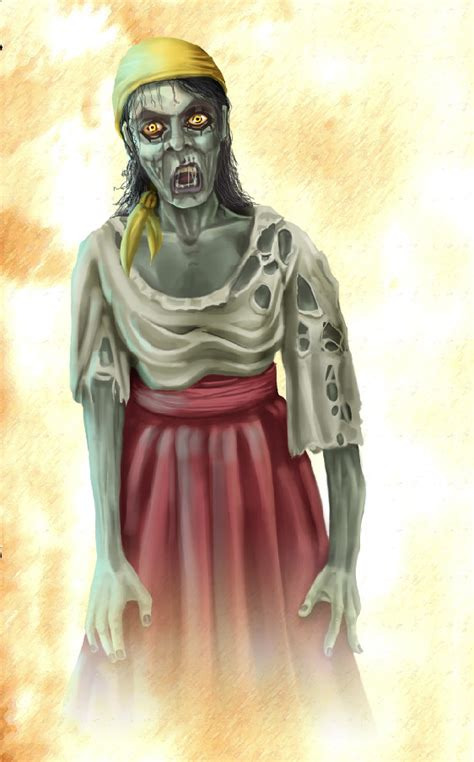
It is described as being capable of changing its shape to appear in the form of a loved one, such as in the likeness of a child's mother, to lure its victims into the forest and feed them with shrimp (camarones peneídos) to keep them docile. This deception is referred to as entundamiento and a person in this state of pacified stupor is called entundado.
Her shapeshifting abilities are said to be imperfect, as this doppelgänger of sorts would always have a wooden leg in the shape of a molinillo, or wooden kitchen utensil used to stir hot drinks such as chocolate or aguapanela. The monster, however, is very cunning when trying to hide this defect from its would-be victims. In other versions, it appears to male loggers or hunters working deep into the jungle as a beautiful woman that tries to lure a man away, so it can reveal its hideous nature and suck his blood and drink it or devour him as a wild animal like bears.
4 notes
·
View notes
Text
Tsul 'Kalu
Tsul 'Kalu is a legendary figure of Cherokee mythology that plays the role of "the great lord of the game," and as such is frequently invoked in hunting rites and rituals.
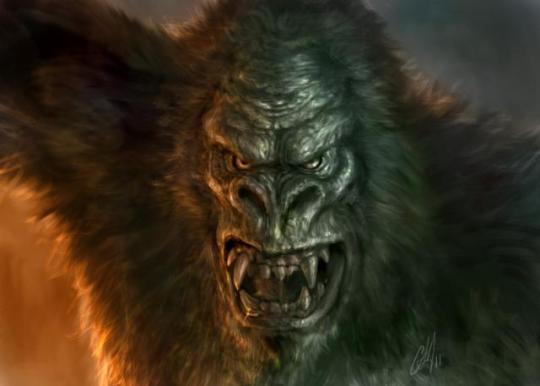
Pic by chris sclaf
The tale is one of the best known Cherokee legends and was recorded by Europeans as early as 1823, often using the spelling, Tuli cula. The name Tsul 'Kalu means literally "he has them slanting/sloping", is understood to refer to his eyes, although the word eye (akta, plural dikta) is not a part of it. In the plural form, it is also the name of a traditional race of giants in the far west.
He is said to dwell in a place called Tsunegun'yi. The words Tsul and Tsune and their variations appear in a number of Cherokee place names throughout the Southeastern United States, especially in western North Carolina and eastern Tennessee.
Tsul`kälû' Tsunegûñ'yï is a 100-acre patch on a slope of the mountain Tanasee Bald in Jackson County, North Carolina, on the ridge upon which the boundary of Haywood, Jackson, and Transylvania Counties converge. It is believed Tsul 'Kalu was responsible for clearing the spot for his residence. The name is sometimes corrupted by Europeans to Jutaculla; consequently the area is also known as the "Jutaculla Old Fields". There is also a large slab of soapstone called "Jutaculla Rock" nearby, which is covered with strange scratches and carvings. These markings are said to have been made by the giant when he would jump from his home on the mountain to the creek below.
Another place associated with Tsul 'Kalu, Tsula'sinun'yi (literally "where the footprint is"), is located on the Tuckasegee River, about a mile above Deep Creek in Swain County, North Carolina. Impressions said to have been the footprints of the giant Tsul`kälû' and a deer was found on a rock that was destroyed during railroad building.
1 note
·
View note
Text
Trauco
In the traditional Chilote mythology of Chiloé, Chile, the Trauco is a humanoid creature of small stature—similar to a dwarf or goblin—who lives deep in the forest. It has an ugly face and legs without feet.
The Trauco is a mythical entity that inhabits the woods of Chiloé, an island in the south of Chile. It is a child of the snake god Coi Coi-Vilu. It has a powerful magnetism that attracts young and middle-aged women. According to myth, the Trauco's wife is the wicked and ugly Fiura. The Trauco carries a small stone-headed hatchet that he uses to strike trees in the forest to symbolize his sexual potency.
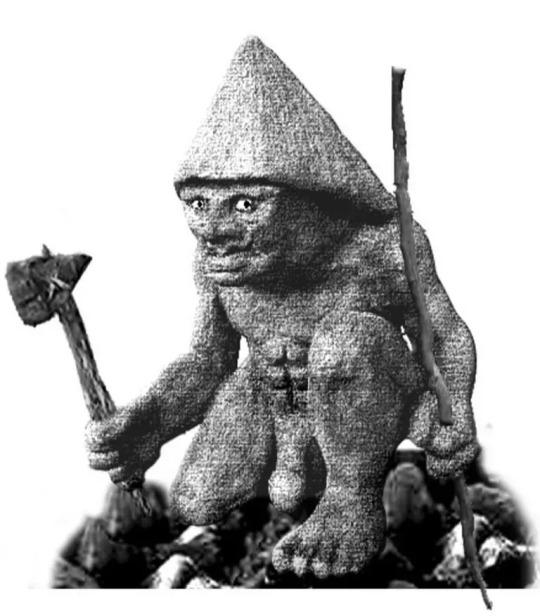
Upon being chosen by him, any woman—even if she's asleep—will go to the Trauco; bewitched and helpless against his sexual allure, she falls at his feet and proceeds to engage in sexual intercourse with him. Some men of Chiloé fear the Trauco, as they believe his gaze can be deadly.
When a single woman is pregnant and no one steps forward as the father, people assume that Trauco is the father. Because the creature is irresistible, the woman is considered blameless. The Trauco is sometimes invoked to explain sudden or unwanted pregnancies, especially in unmarried women.
Edith Rebolledo Muller, MSc in Sociology, states the following: "In fact, teen pregnancy has its explanation in this myth as a way to justify this shame. Then it will be cleansed by marriage, as an institution that allows regulating and holding bodies into submission".
3 notes
·
View notes
Text
Shellycoat
Shellycoats are considered to be relatively harmless; they may mislead wanderers, particularly those they think are trespassing upon the creature's territory, but without malice. A common tactic of a shellycoat would be to cry out as if drowning and then laugh at the distracted victim.
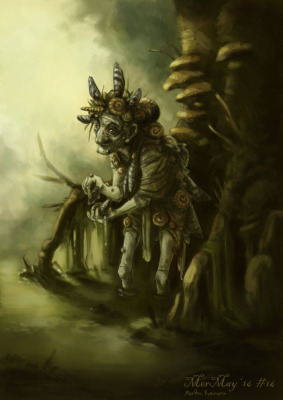
As described above, the shellycoat shares many of the traits of the Brag, Kelpie and Nix.
Jacob Grimm stated in his Deutsche Mythologie that the Scottish goblin Shellycoat is one and the same as the German Schellenrock, that is bell-coat:
A pück [home-sprite] served the monks of a Mecklenburg monastery for thirty years, in kitchen, stall and elsewhere; he was thoroughly good-natured, and only bargained for 'tunicam de diversis coloribus, et tintinnabulis plenam.' [a "parti-coloured coat with tinkling bells"] In Scotland there lived a goblin Shellycoat, and we saw that the dwarfs of the Mid. Ages also loved bells [schellen; and schellenkappe is Germ. for cap and bells]. The bells on the dress of a fool still attest his affinity to the shrewd and merry goblin (fol, follet); see Suppl.
Thomas Keightly quotes Grimm and classifies the shellycoat as a type of brownie.:
Another name by which the domestic spirit was known in some parts of Scotland was Shellycoat, of which the origin is uncertain.
The domestic nature of the shellycoat emphasized by Grimm and Keightly stands in contradistinction to the wild nature of the water sprites mentioned in other sources.
1 note
·
View note
Text
Shaitan
A shaitan or shaytan is an evil spirit in Islam, inciting humans and the jinn to sin by "whispering" in their hearts. Although invisible to humans, shayāṭīn are imagined to be ugly and grotesque creatures created from (hell-)fire.
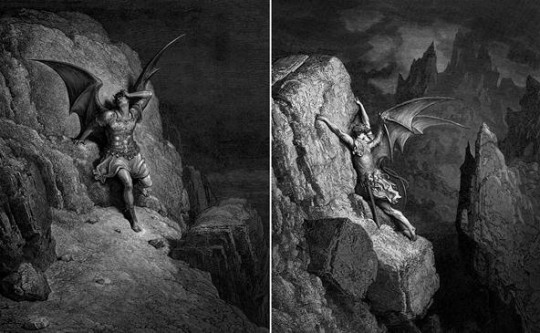
Pic by Gustave Dore
The Quran speaks of various ways that the shayāṭīn tempt humans into sin. They may teach sorcery, float below the heavens to steal the news of the angels, or lurk near humans without being seen. Iblīs, called ash-Shayṭān ("the Devil" or "Satan"), is their leader. Ḥadīth literature holds the shayāṭīn responsible for various calamities which may affect personal life. Both the ḥādīth literature and Arab folklore usually speak of the shayāṭīn in abstract terms, describing their evil influence only. For example, according to a hadith, during Ramadan they are said to be chained in hell.
According to Muslim philosophical writings, the shayāṭīn struggle against the noble angels in the imaginal reality called 'ālam al-mithāl or 'ālam al-malakūt over the human mind, consisting of both angelic and devilish qualities. Some writers describe the shayāṭīn as expressions of God's fierce attributes and actions.
The Arabic term Šayṭān (Arabic: شَيْطَان) originated from the triliteral root š-ṭ-n ("distant, astray") and is cognate to Satan. It has a theological connotation designating a creature distant from the divine mercy. In pre-Islamic Arabia, this term was used to designate an evil spirit, but only used by poets who were in contact with Jewish and Christian tribes. According to Umar Sulaiman Al-Ashqar, Shaytan in the Arabic language refers to every rebellious person
With the emergence of Islam, the meaning of shayāṭīn moved closer to the Christian concept of devils. The term shayāṭīn appears similarly in the Jewish Book of Enoch, denoting the hosts of Satan. The term ultimately derives from the Jewish Book of Job. Taken from Islamic literary sources, the term shayāṭīn may be translated as "demons", "satans", or "devils".
In the Quran, shayāṭīn are mentioned as often as angels. The shayāṭīn are mentioned less frequently than Šayṭān, but they are equally hostile to God's order (sharīʿa). They teach sorcery to humans, inspire their friends to dispute with the faithful make evil suggestions towards both humans and jinn, and secretly listen to the council of the angels. The Quran speaks about the junud Iblīs, the (invisible) hosts of Iblīs (comparable to the junud of angels fighting along Muhammad. Yet, despite the reluctant nature of the shayāṭīn, they are ultimately under God's command, working as his instruments and not forming their own party. According to the Quran, God made the shayāṭīn slaves for Solomon, God assigns the shayāṭīn as companions to the unbelievers, and God sends the shayāṭīn as enemies to misbelievers to incite them against each other. It is God who leads astray and puts people on the straight path. Both good and evil are caused by God in Islam.
A single Šayṭān (the Devil, mostly thought of as Iblīs) caused Adam to eat from the forbidden tree, arguing, God only prohibited its fruit, so they shall not become immortal, as narrated in the Quran. He makes people forgetful, protects wicked nations, encourages to murderand rebellion and betrays his followers, as seen in the Battle of Badr. The Quran explicitly warns people not to follow the Šayṭān, implying that humans are free to choose between the path of God or the one of Šayṭān. But Šayṭān only promises delusion . portrays Šayṭān as a false friend, who betrays those who follow him. Šayṭān can only act with God's permission. The Quranic story of Iblīs, who represents the shayāṭīn in the primordial fall, shows that the shayāṭīn are both subordinative and created by God. Šayṭān proclaims that he fears God ('akhafu 'llah), which can mean both, that he is revering or frightened about God (the latter one the preferred translation).
The ḥādīth narrations are more related to the practical function of the shayāṭīn in everyday life. They usually speak about šayṭān, instead of Iblīs or shayāṭīn, given the ḥādīth literature links them to their evil influences, not to them as proper personalities. Yet, ḥādīth narrations indicate that they are composed of a body. The shayāṭīn are said to eat with their left hand, therefore Muslims are advised to eat with their right hand. Shayāṭīn, although invisible, are depicted as immensely ugly. The sun is said to set and rise between the horns of a šayṭān and during this moment, the doors to hell are open, thus Muslims should not pray periodically at this time. The shayāṭīn are chained in hell during Ramadan. Shayāṭīn are sent by Iblis to cause misery among humans and return to him for report. A šayṭān is said to tempt humans through their veins. Shayāṭīn try to interrupt ritual Muslim prayer, and if a šayṭān succeeds in confusing a Muslim, the Muslim is supposed to prostrate two times and continue. Satan and his minions battle the angels of mercy over the soul of a sinner; however, they are referred to as "angels of punishment" instead of shayāṭīn.
When it comes to the issue of invisible creatures, mufassirs usually focus on shayāṭīn and evil jinn and although they are similar in threatening humans, they are distinguished by one another. While the jinn share many attributes with humans, like having free will, and the ability to reason, and thus different types of believers, the shayāṭīn are exclusively evil. Further, the jinn have a limited lifespan, but the shayāṭīn die only when their leader ceases to exist. The father of the jinn is Al-Jann and the father of the shayāṭīn is Iblis.
In Tafsir al-Kalbi about Ibn 'Abbas, he is quoted as saying: Iblis is cursed and made his soldiers two teams, so he sent one team of them to the humans and another team to the jinn. In another account of him, the jinn are offspring of al-jann, unlike devils. The devils were born by Iblis and they perish only with him and the jinn die including the believer and the infidel (...) — Mahmud al-Alusi, "The Spirit of Meaning", Surah 6:112
Engku Ansaruddin Agus states that jinn, shaitan, and iblis are three different things; Iblis is the name, given by God, to an angel (Azazil) who disobeyed. Shaitan is a title for those who join Azazil's army, trained to destroy humans. Abu Mufti distinguishes in his commentary of Abu Hanifa's "al-Fiqh al-absat" that all angels, except Harut and Marut, are obedient. But all shayāṭīn, except Ham ibn Him ibn Laqis Ibn Iblis, are created evil. Al-Damiri reports from ibn Abbas, that the angels will be in paradise, the shayāṭīn will be in hell, and among the jinn and humans, some will be in paradise and some will be in hell. Only humans and jinn are created with fitra, meaning both angels and shayāṭīn lack free will and are settled in opposition.
Neither the origin of the shayāṭīn nor their creation is described in the Quran. Since their leader describes themselves in the Quran as being "created from fire", shayāṭīn are thought to be created from that. More precisely, sometimes considered the fires of hell in origin. Most mufassirs agree that the shayāṭīn are the offspring of Iblis. Abu Ishaq al-Tha'labi reports that God offered Iblis support by giving him offspring, which are the shayāṭīn. Others describe the shayāṭīn as fallen spirits (sometimes heavenly jinn, sometimes fiery angels), outcast from the presence of God. Ibn Barrajan argues that the angels consist of two tribes: One created from light and one from fire, the latter being the shayāṭīn. Ibn Arabi describes the jinn as fire-made spiritual entities from the spiritual world. When they disobey God, they turn into shayāṭīn. Qadi Baydawi argues that shayāṭīn are perhaps not essentially different from angels, but differ only in their accidents and qualities.
Since the term shaitan is also used as an epithet to describe malevolent jinn (and humans), it is sometimes difficult to properly distinguish between shayāṭīn and evil jinn in some sources. Generally, Satan and his hosts of devils (shayatin) appear in traditions associated with Jewish and Christian narratives, while jinn represent entities of polytheistic background.
Shayāṭīn are linked to Muslim ritual purity. Ritual purity is important in attracting angels, while shayāṭīn approach impurity and filthy or desacralized places. Before reciting the Quran, Muslims should take wudu/abdest and seek refuge in God from the shayāṭīn. Reciting specific prayers is supposed to protect against the influence of the shayāṭīn.
Islamic philosophical cosmology asserts the belief in a singular God. In Islam, reverence is held for all the Abrahamic Prophets, including prominent figures like Moses and Jesus. Islamic tradition maintains that Prophets were sent to guide every tribe or community throughout history, with divine revelations being imparted to mankind repeatedly. However, the purity of these messages was sometimes compromised due to human tendencies such as corruption, jealousy, and heresy. Islam affirms that Muhammad was the final Prophet, and it asserts that the Quran, the holy book of Islam, remains unaltered by human hands.
It divides living beings into four categories: Animals, humans, angels, and shayāṭīn. Al-Farabi defines angels as reasonable and immortal beings, humans as reasonable and mortal beings, animals as unreasonable and mortal beings, and shayāṭīn as unreasonable and immortal beings. He supports his claim with the Quranic verse in which God grants Iblis respite until the day of resurrection.
Likewise, al-Ghazali divides human nature into four domains, each representing another type of creature: Animals, beasts, devils, and angels. Traits humans share with bodily creatures are animals, which exist to regulate ingestion and procreation and the beasts, used for predatory actions like hunting. The other traits humans share with the jinn and root in the realm of the unseen. These faculties are of two kinds: That of angels and the shayāṭīn. While the angels endow the human mind with reason, advise virtues, and lead to worship of God, the šayṭān perverts the mind and tempts it to commit lies, betrayals, and deceits, thus abusing the spiritual gift. The angelic nature instructs how to use the animalistic body properly, while the šayṭān perverts it. In this regard, the plane of a human is, unlike who's of the jinn and animals, not pre-determined. Humans are potentially both angels and devils, depending on whether the sensual soul or the rational soul develops.
The Brethren of Purity understand shayāṭīn as ontological forces, manifesting in everything evil.
Following the cosmology of Wahdat al-Wujud, Haydar Amuli specifies that angels reflect God's names of light and beauty, while the shayāṭīn God's attributes of "Majesty", "The Haughty" and "Domineering".Ibn Arabi, to whom Haydar Amuli's cosmology is attributed to, although making a clear distinction between the devils and the angels, interpreted shayāṭīn as beings of a similar function to that of angels, as sent and predescribed by God, in his Al-Futuhat al-Makkiyya.
Sufi writers connect the descriptions of shayāṭīn mentioned in hadith literature to human psychological conditions. Devilish temptations are distinguished from the angelic assertions, by that the angels suggest piety by sharia, the shayāṭīn against God's law and sinful acts. He further elaborates an esoteric cosmology, visualizing a human's heart as the capital of the body, in constant struggle between reason and carnal desires invoked by the shayāṭīn. Ali Hujwiri similarly describes the shayāṭīn and angels mirroring the human psychological condition, the shayāṭīn and carnal desires on one side, and the spirit and the angels on the other. The evil urges related to the al-nafs al-ammarah in Sufism are also termed div.
2 notes
·
View notes
Text
Prende
Prende or Premte is the goddess of dawn, love, beauty, fertility, health and protector of women, in the Albanian pagan mythology. She is also called Afër-dita, an Albanian phrase meaning "near day", "the day is near", or "dawn", in association with the cult of the planet Venus, the morning and evening star. Her sacred day is Friday, named in Albanian after her: e premte, premtja (Gheg Albanian: e prende, prendja). In Albanian mythology Prende appears as the daughter of Zojz, the Albanian sky and lighning god.
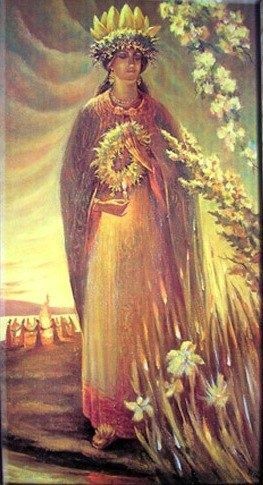
Thought to have been worshiped by the Illyrians in antiquity, Prende is identified with the cult of Venus and she was worshipped in northern Albania, especially by the Albanian women, until recent times. Originally a pre-Christian deity, she was called "Saint Veneranda" (ShënePremte or Shën Prende), identified by the Catholic Church as Saint Anne, mother of Virgin Mary. She was so popular in Albania that over one in eight of the Catholic churches existing in the late 16th and the early 17th centuries were named after her. Many other historical Catholic and Orthodox churches were dedicated to her in the 18th and 19th centuries.
Dialectal variants include: Gheg Albanian P(ë)rende (def. P(ë)renda), Pren(n)e (def. Pren(n)a); Tosk Albanian: Premte (def. Premtja), Preme (def. Prema).
Prende is also called Afërdita (Afêrdita in Gheg Albanian) in association with the cult of the planet Venus, the morning and evening star, which in Albanian is referred to as (h)ylli i dritës, Afërdita "the Star of Light, Afërdita" (i.e. Venus, the morning star) and (h)ylli i mbrëmjes, Afërdita (i.e. Venus, the evening star). Afër-dita, an Albanian phrase meaning "near day", "the day is near", or "dawn", is the native Albanian name of the planet Venus. Afro-dita is its Albanian imperative form meaning "come forth the day/dawn".
The Albanian translation of "evening" is also rendered as πρέμε premë in the Albanian-Greek dictionary of Marko Boçari.
In northern Albania, Prende is referred to as Zoja Prenne or Zoja e Bukuris "Goddess/Lady Prenne" or "Goddess/Lady of Beauty".
The Albanian name Premtë or P(ë)rende is thought to correspond regularly to the Ancient Greek counterpart Περσεφάττα (Persephatta), a variant of Περσεφόνη (Persephone). The theonyms have been traced back to the Indo-European *pers-é-bʰ(h₂)n̥t-ih₂ ("she who brings the light through").
The Albanian phrase afro dita 'come forth the day/dawn' traces back to Proto-Albanian *apro dītā 'come forth brightness of the day/dawn', from Indo-European *h₂epero déh₂itis. The theonym Aprodita is attested in Messapic inscriptions in Apulia.
In the Albanian pagan mythology Prende is the goddess of dawn, love, beauty, fertility and health. She is considered the Albanian equivalent of the Roman Venus, Norse Freyja and Greek Aphrodite.
According to some Albanian traditions, Prende is the daughter of Zojz, the Albanian sky and lightning god. Associated with the dawn goddess, the epithet "daughter of the sky-god" is commonly found in Indo-European traditions.
According to folk beliefs, swallows, called Pulat e Zojës "the Lady's Birds", pull Prende across the sky in her chariot. Swallows are connected to the chariot by the rainbow (Ylberi), which the people also call Brezi or Shoka e Zojës "the Lady's Belt".
The common Albanian name nepërkë for the venomous snake adder, viper appears in the Arbëresh variety of Calabria as nepromtja, probably based on Prende / Premte.
15 notes
·
View notes
Text
Pillan
The Pillan (plural pillanes) are powerful and respected male spirits in Mapuche mythology.
According to legend, the Pillan are good spirits, but they can also cause disasters, since they also punish (or they allow the wekufe to punish) with drought or flood, earthquakes, or diseases. The Antü is the most powerful Pillan, who governs the others. In the Mapuche tradition, a man that follows the laws of the admapu can also become a Pillan after death. The Mapuche perform a ngillatun ceremony for the Pillan, for the latter to grant benefits to the people, and to thank them for their gifts.
The Pillan have been described as spirits that live in the Wenumapu (a spiritual world of good), and those that inhabit the Earth generally live inside the volcanoes. (Example: Osorno and Quetrupillán Volcano). The accompanying female spirits of the Pillan are the Wangulen spirits.

9 notes
·
View notes
Text
Nian
A nian is a beast in Chinese mythology. Nian live under the sea or in the mountains. The Chinese character nian more usually means "year" or "new year". The earliest written sources that refer to the nian as a creature date to the early 20th century. As a result, it is unclear whether the nian creature is an authentic part of traditional folk mythology, or a part of a local oral tradition that was recorded in the early 20th century. Nian is one of the key characters in the Chinese New Year. Scholars cite it as the reason behind several practices during the celebration, such as wearing red clothing and creating noise from drums and fireworks.
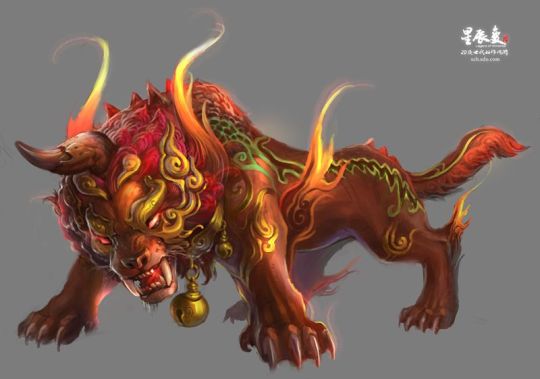
Once every year at the beginning of Chinese New Year, the nian would come out of its hiding place to feed, mostly on people and animals. During the winter, when food was scarce, it would raid villages, eating the crops and sometimes the villagers themselves - particularly their children. Several accounts describe its appearance, with some claiming that it resembles a flat-faced lion with the body of a dog and prominent incisors. Other authors described it as larger than an elephant with two long horns and many sharp teeth. The weaknesses of the nian are purported to be a sensitivity to loud noises, fire, and a fear of the color red.
Some local legends attribute the Chinese lion dance to the nian. The tradition has its origins in a story of a nian's attack on a village. After the attack, the villagers discussed how to make the nian leave them in peace. Since it was discovered that the beast was afraid of the color red, people put red lanterns and spring scrolls on their windows and doors. They would also leave food at their doorstep in a bid to divert it from eating humans. Other sources say that an old man who came to visit actually informed the villagers of the nian's weaknesses. The traditions of firecrackers, red lanterns, and red robes found in many lion dance portrayals originate from the villagers' practice of hitting drums, plates, and empty bowls, wearing red robes, and throwing firecrackers, causing loud banging sounds to intimidate the nian. According to this same myth, it was captured by Hongjun Laozu, an ancient Taoist monk, and became his mount.
Various aspects of cultural practices relating to Chinese New Year are part of the nian legend. These cultural practices are recorded in ancient texts, though none of them refer to a creature called nian.
The Erya records that the character nian (年) was first used to mean "year" during the Zhou dynasty, replacing terms used in previous eras. The Shuowen Jiezi records that the character nian meant "ripeness of grains" and was composed of the character "he" (禾, rice plant) and "qian" (千, indicating the sound) and quotes the Chunqiu, which uses it in the sense of a great harvest.
The attributes of the nian creature in the modern legend, of fear of noise and fire, correlate with ancient legends relating to the use of firecrackers to drive off ape-like creatures in the mountains called shanxiao, first recorded in the Shanhaijing.
The practice of sweeping and cleaning at the start of the year is recorded in Zhou dynasty sources as intended to ward off plague spirits, and the practice of using music and drama to receive gods and ward off plague spirits is recorded from the same era. The creature's role in the celebration of the Chinese New Year is highlighted by the way the Chinese call this holiday Guo Nian, which means "pass over nian" or "overcome nian."
24 notes
·
View notes
Text
Nasnas
In Arab folklore, the Nasnas is a monstrous creature. According to Edward Lane, the 19th century translator of The Thousand and One Nights, a nasnas is "half a human being; having half a head, half a body, one arm, one leg, with which it hops with much agility". In Somali folklore there is a similar creature called "xunguruuf" or "Hungruf". It is believed it can kill a person by just touching them and the person would be fleshless in mere seconds. It was believed to be the offspring of a jinn called a Shiqq and a human being. A character in "The Story of the Sage and the Scholar", a tale from the collection, is turned into a nasnas after a magician applies kohl to one of his eyes. The nasnas is mentioned in Gustave Flaubert's The Temptation of Saint Anthony.
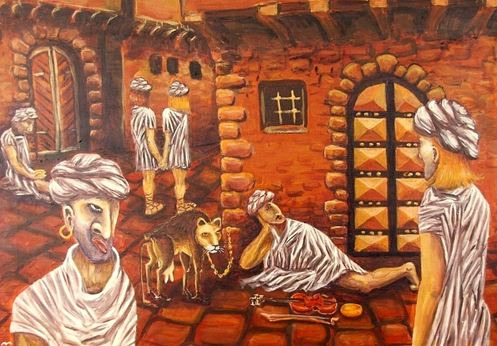
5 notes
·
View notes
Text
Nalusa Falaya
The Nalusa Falaya is a creature from Choctaw mythology. Its name is literally translated to "long black being" and it is usually described as a tall skinny humanoid with long ears. It has however been described as slithering like a snake and/or melting into a shadow .
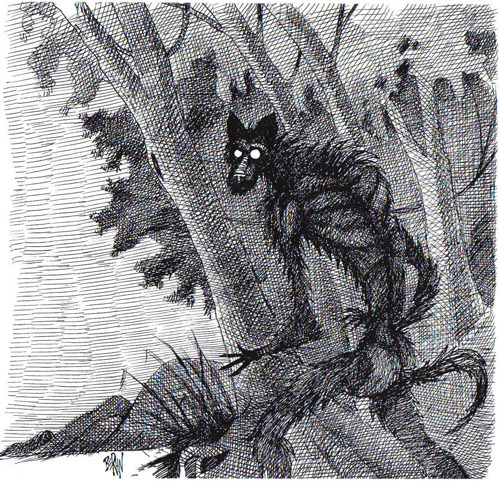
Pic by berlinsart deviantart
The Nalusa Falaya lingers in the long shadows in the dusk and frightens children who stay out too late as well as the occasional careless hunters.
It is described as planting thorns into a hunter's hands and feet giving them the power to do evil to others. The hunters remain ignorant of this until their malevolent actions reveal it. Similar to witch myths from Europe and colonized America these people were too afraid to tell others of their power so as to not be prosecuted.
The children of the Nalusa Falaya have the ability to remove their internal organs and appear as small bodies of light seen along the edges of marshes similar to the will-o'-wisps.
9 notes
·
View notes
Text
La Sayona
La Sayona is a legend from Venezuela, represented by the vengeful spirit of a woman that shows up only to men that have love affairs out of their marriages. The name "Sayona" refers to the cloth the ghost wears which is a long white dress similar to a medieval undergarment.
The legend claims that when this woman appears she asks for a ride, and after a while when the victim tries to see her face, he notices that she has instead a skull with horrible teeth.

The legend says that "La Sayona" was a young woman named Casilda. She lived in a small town in the plains of Venezuela and was the most beautiful girl there. She was married to a great man, caring and loving. Casilda and her husband had a baby boy. One day, Casilda was swimming naked in a nearby river and a villager saw her. After that, the man would always follow her and watch her bathe in the river. One day Casilda saw him and told him to leave her alone; he ignored her, and instead told her that he was there to warn her: "Your husband is having an affair with none other than your mother," he said. Casilda ran home and found her husband asleep with the baby in his arms. Blind with anger, she burned the house with them inside. Villagers could hear their screams while Casilda ran to her mother's house. She found her on the patio and attacked her with a machete, striking her in the stomach. As the mother bled to death, she cursed Casilda telling her that from then on she would have to avenge all women by killing their unfaithful husbands. And from that day forward Casilda became "La Sayona".
In other versions of the tale, Sayona appears to men working in the jungle. She manifests when her unsuspecting victims talk to their workmates about sex or think of women they left behind in their hometown. Sayona appear to such men, assuming the likeness of beautiful woman, or a loved one, and lures them into the forest so she could reveal her animal-like features and devour them, or mangle them, leaving their wretched bodies for their companions to find.
1 note
·
View note
Text
Kappa
A kappa is a reptiloid kami with similarities to yōkai found in traditional Japanese folklore. Kappa can become harmful when they are not respected as gods. They are typically depicted as green, human-like beings with webbed hands and feet and turtle-like carapaces on their backs. A depression on its head, called its "dish" (sara), retains water, and if this is damaged or its liquid is lost (either through spilling or drying up), the kappa is severely weakened.

Pic by Duncan Hopkins
The kappa are known to favor cucumbers and love to engage in sumo wrestling. They are often accused of assaulting humans in water and removing a mythical organ called the shirikodama from their victim's anus.
The name kappa is a contraction of the words kawa (river) and wappa, a variant form of 童 warawa (also warabe) "child". Another translation of kappa is "water sprites". The kappa are also known regionally by at least eighty other names such as kawappa, kawako, kawatarō, gawappa, kōgo, suitengu.
It is also called kawauso 'otter', dangame 'soft-shelled turtle', and enkō 'monkey', suggesting it outwardly resembles these animals. The name komahiki or "steed-puller" alludes to its reputed penchant to drag away horses.
The kappa has been known as kawako in Izumo (Shimane Prefecture) where Lafcadio Hearn was based, and gatarō was the familiar name of it to folklorist Kunio Yanagita from Hyōgo Prefecture.
Kappa are said to be roughly humanoid in form and about the size of a child, inhabiting the ponds and rivers of Japan. Clumsy on land, they are at home in the water, and thrive during the warm months. They are typically greenish in color (or yellow-blue), and either scaly or slimy skinned, with webbed hands and feet, and a turtle-like carapace on their back. Inhuman traits include three anuses that allow them to pass three times as much gas as humans. Despite their small stature they are physically stronger than a grown man.
The kappa are sometimes said to smell like fish, and they can swim like them.
According to some accounts, a kappa's arms are connected to each other through the torso and can slide from one side to the other. While they are primarily water creatures, they do on occasion venture onto land. When they do, the "dish" on their head can be covered with a metal cap for protection.
A hairy kappa is called a hyōsube.
Kappa are usually seen as kami of the water. Their actions are from comparatively minor misdemeanors, such as looking up women's kimono if they venture too near to water, to outright malevolence, such as drowning people and animals, kidnapping children, raping women and at times eating human flesh. Though sometimes menacing, they may also behave amicably towards humans. While younger kappa are frequently found in family groups, adult kappa live solitary lives. However, it is common for kappa to befriend other yōkai and sometimes even people.
Folk beliefs claim the cucumber as their traditional favorite meal. At festivals, offerings of cucumber are frequently made to the kappa. Sometimes the kappa is said to have other favorite foods, such as the Japanese eggplant, soba (buckwheat noodles), nattō (fermented soybeans), or kabocha (Japanese pumpkin).
In Edo (old Tokyo), there used to be a tradition where people would write the names of their family members on cucumbers and send them afloat into the streams to mollify the kappa and prevent the family from coming to harm in the streams. In some regions, it was customary to eat cucumbers before swimming as protection, but in others it was believed that this act would guarantee an attack.
A cucumber-filled sushi roll is known as a kappamaki.
As water monsters, kappa have been blamed for drownings, and are often said to try to lure people into water and pull them in with their great skill at wrestling. They are sometimes said to take their victims for the purpose of drinking their blood, eating their livers, or gaining power by taking their shirikodama, a mythical ball said to contain the soul, which is located inside the anus.
Kappa have been used to warn children of the dangers lurking in rivers and lakes, as kappa have been often said to try to lure people to water and pull them in. Even today, signs warning about kappa appear by bodies of water in some Japanese towns and villages.
Kappa are also said to victimize animals, especially horses and cows. The motif of the kappa trying to drown a horse is found all over Japan.
Lafcadio Hearn wrote of a story in Kawachimura near Matsue where a horse-stealing kappa was captured and made to write a sworn statement vowing never to harm people again.
In many versions the kappa is dragged by the horse to the stable where it is most vulnerable, and it is there it is forced to submit a writ of promise not to misbehave.
It was believed that there were a few means of escape if one was confronted with a kappa. Kappa are obsessed with politeness, so if a person makes a deep bow, it will return the gesture. This results in the kappa spilling the water held in the "dish" (sara) on its head, rendering it unable to leave the bowing position until the plate is refilled with water from the river in which it lives. If a person refills it, the kappa will serve that person for all eternity. A similar weakness of the kappa involves its arms, which can easily be pulled from its body. If an arm is detached, the kappa will perform favours or share knowledge in exchange for its return.
Another method of defeat involves shogi or sumo wrestling: a kappa sometimes challenges a human being to wrestle or engage in other tests of skill. This tendency is easily used to encourage the kappa to spill the water from its sara. One notable example of this method is the folktale of a farmer who promises his daughter's hand in marriage to a kappa in return for the creature irrigating his land. The farmer's daughter challenges the kappa to submerge several gourds in water. When the kappa fails in its task, it retreats, saving the farmer's daughter from the marriage. Kappa have also been driven away by their aversion to iron, sesame, or ginger.
Kappa are not entirely antagonistic to human beings.
Once befriended, kappa may perform any number of tasks for human beings, such as helping farmers irrigate their land. Sometimes, they bring fresh fish, which is regarded as a mark of good fortune for the family receiving it. They are also highly knowledgeable about medicine, and legend states that they taught the art of bone setting to human beings. There are also legends that Kappa will save a friendly human from drowning.
Along with the oni and the tengu, the kappa is among the best-known yōkai in Japan.
The kappa is known by various names of the creature vary by region and local folklore. In Shintō, they are often considered to be an avatar (keshin) of the Water Deity or suijin.
Shrines are dedicated to the worship of kappa as water deity in such places as Aomori Prefecture or Miyagi Prefecture. There were also festivals meant to placate the kappa in order to obtain a good harvest, some of which still take place today. These festivals generally took place during the two equinoxes of the year, when the kappa are said to travel from the rivers to the mountains and vice versa.
The best known place where it has been claimed Kappa reside is in the Kappabuchi waters of Tōno in the Iwate Prefecture. The nearby Jōkenji In Tōno, there is a Buddhist temple that has komainu dog statues with depressions on their heads reminiscent of the water-retaining dish on the kappa's heads, said to be dedicated to the kappa which according to legend helped extinguish a fire at the temple. The Kappa is also venerated at the Sogenji Buddhist temple in the Asakusa district of Tokyo where according to tradition, a mummified arm of a Kappa is enshrined within the chapel hall since 1818.
In his Tōno Monogatari, Kunio Yanagita records a number of beliefs from the Tōno area about women being accosted and even impregnated by kappa. Their offspring were said to be repulsive to behold, and were generally buried.
Similar folklore can be found in Asia and Europe. Like the Japanese description of the beast, in Chinese and in Scandinavian lore this beast is infamous for kidnapping and drowning people as well as horses.
The siyokoy of the Philippine islands is also known for kidnapping children by the water's edge.
A frog-face vodyanoy is known in Slavic mythology. A green human-like being named a vodník is widely known in western Slavic folklore and tales, especially in the Czech Republic or Slovakia.
In German mythology, a similar creature is known as Wassermann, Nix, or Nickel. They have been mentioned in connection with the larger rivers Elbe and Saale in the eastern part of Germany, but they are most widely connected to Lusatia in South-East Germany. This is not entirely surprising, as the area is not only close to Poland and Czech Republic, but also home to the Slavic minority of the Sorbs.
64 notes
·
View notes
Text
Hibagon
The Hibagon or Hinagon is the Japanese equivalent of the North American Bigfoot or the Himalayan Yeti. Sightings have been reported since the 1970s around Mount Hiba in the Hiroshima Prefecture.
The Hibagon is described as a "black creature with white hands and large white feet, standing about five feet tall.", and has been said to resemble a gorilla.

The Hibagon has a large nose, large deep glaring eyes and is covered with bristles. Theories to account for this cryptid range from a gorilla, a wild man, or a deserter from the Japanese chefs, to an individual ravaged by atomic radiation from the nuclear attack on Hiroshima.
A sighting from 1972 reports that the creature "has a chocolate brown face and is covered with brown hair ... [and] is said to have 'deep glaring eyes', in two reports by a Mr. Sazawa and a Mrs. Harada, the creature took no hostile action and fled from four armed residents intent on hunting it."
Japanese Boy Scouts, "claim to find footprints 25 cm (10 in) long and 15 cm (6 in) wide."
25 notes
·
View notes